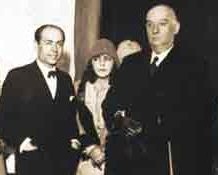José Fioravanti
José Fioravanti | |
|---|---|
Argentine | |
| Known for | civic monuments |
| Style | sculptor |
José Fioravanti (August 4, 1896 – October 10, 1977) was a prolific Argentine sculptor known for the many civic monuments he created.
Life and work
Fioravanti was born in
His work during the next several years consisted mainly of Realist

He then secured two solo exhibitions in Buenos Aires, including a 1928 Friend of the Arts event inaugurated by President Marcelo Torcuato de Alvear, who commissioned Fioravanti to create decorative reliefs for the Casa Rosada's interiors.[3] Fioravanti returned to Paris in 1929. He earned increasing renown in the French capital, and in 1934 was honored with a solo exhibition at the Galerie nationale du Jeu de Paume.[4]
Returning to Argentina in 1935, Fioravanti was appointed Professor at the
Another significant series of Fioravanti's work would adorn the National Flag Memorial, a landmark overlooking the Paraná River in the city of Rosario. The memorial, built between 1947 and 1957, would feature Fioravanti's monument to Manuel Belgrano and five allegorical sculptures; these were created in bronze and travertine. It would be the second significant collaboration with Alfredo Bigatti, who created the allegories representing the Four Freedoms for the Roosevelt memorial.[5]
Fioravanti died in 1977, in Buenos Aires.[1]
Images
-
Simón Bolivar (Buenos Aires, 1942)
References
- ^ a b c d "José Fioravanti: Homenaje a un escultor". Fundación Creer y Crecer.
- ^ a b "José Fioravanti". Biografías y Vidas.
- ^ "Malba cierra el año con una importante exposición: "Amigos del Arte 1924–1942"". Pandorama.
- ^ "José Fioravanti". Monumento a la Bandera. Archived from the original on 2011-06-26.
- ^ a b "Monumentos". Primera Plana.
- ^ "Obra escultórica de José Fioravanti en Villa María". El Diario del Centro del País. Archived from the original on 2011-09-28.
- ^ Manual informativo de la ciudad de Buenos Aires [Information manual of the city of Buenos Aires] (in Spanish). Buenos Aires, Argentina: Instituto Histórico de la Ciudad de Buenos Aires. 1991. p. 370.


![Monument for Ludwig van Beethoven (Plaza Lavalle [es], 1944)[7]](http://upload.wikimedia.org/wikipedia/commons/thumb/f/f4/Memorial_a_Beethoven.JPG/127px-Memorial_a_Beethoven.JPG)